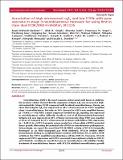Por favor, use este identificador para citar o enlazar a este item:
http://hdl.handle.net/10261/197754COMPARTIR / EXPORTAR:
 SHARE SHARE
 CORE
BASE CORE
BASE
|
|
| Visualizar otros formatos: MARC | Dublin Core | RDF | ORE | MODS | METS | DIDL | DATACITE | |

| Título: | Association of high microvessel αvβ3 and low PTEN with poor outcome in stage 3 neuroblastoma: rationale for using first in class dual PI3K/BRD4 inhibitor, SF1126 |
Autor: | Erdreich-Epstein, Anat; Singh, Alok R.; Joshi, Shweta; Vega, Francisco M. CSIC ORCID; Guo, Pinzheng; Xu, Jingying; Groshen, Susan; Ye, Wei; Millard, Melissa; Campan, Mihaela; Morales, Guillermo; Garlich, Joseph R.; Laird, Peter W.; Seeger, Robert C.; Shimada, Hiroyuki; Durden, Donald L. | Palabras clave: | Angiogenesis Integrin αvβ3 Neuroblastoma PI3-kinase inhibitors BRD4 |
Fecha de publicación: | 18-nov-2016 | Editor: | Impact Journals | Citación: | Oncotarget 8(32): 52193-52210 (2017) | Resumen: | Neuroblastoma (NB) is the most common extracranial solid tumor in children. Our previous studies showed that the angiogenic integrin αvβ3 was increased in high-risk metastatic (stage 4) NB compared with localized neuroblastomas. Herein, we show that integrin αvβ3 was expressed on 68% of microvessels in MYCN-amplified stage 3 neuroblastomas, but only on 34% (means) in MYCN-non-amplified tumors (p < 0.001; n = 54). PTEN, a tumor suppressor involved in αvβ3 signaling, was expressed in neuroblastomas either diffusely, focally or not at all (immunohistochemistry). Integrin αvβ3 was expressed on 60% of tumor microvessels when PTEN was negative or focal, as compared to 32% of microvessels in tumors with diffuse PTEN expression (p < 0.001). In a MYCN transgenic mouse model, loss of one allele of PTEN promoted tumor growth, illustrating the potential role of PTEN in neuroblastoma pathogenesis. Interestingly, we report the novel dual PI-3K/BRD4 activity of SF1126 (originally developed as an RGD-conjugated pan PI3K inhibitor). SF1126 inhibits BRD4 bromodomain binding to acetylated lysine residues with histone H3 as well as PI3K activity in the MYCN amplified neuroblastoma cell line IMR-32. Moreover, SF1126 suppressed MYCN expression and MYCN associated transcriptional activity in IMR-32 and CHLA136, resulting in overall decrease in neuroblastoma cell viability. Finally, treatment of neuroblastoma tumors with SF1126 inhibited neuroblastoma growth in vivo. These data suggest integrin αvβ3, MYCN/BRD4 and PTEN/PI3K/AKT signaling as biomarkers and hence therapeutic targets in neuroblastoma and support testing of the RGD integrin αvβ3-targeted PI-3K/BRD4 inhibitor, SF1126 as a therapeutic strategy in this specific subgroup of high risk neuroblastoma. | Versión del editor: | https://doi.org/10.18632/oncotarget.13386 | URI: | http://hdl.handle.net/10261/197754 | DOI: | 10.18632/oncotarget.13386 | E-ISSN: | 1949-2553 |
| Aparece en las colecciones: | (IBIS) Artículos |
Ficheros en este ítem:
| Fichero | Descripción | Tamaño | Formato | |
|---|---|---|---|---|
| stage_3_neuroblastoma.pdf | 3,28 MB | Adobe PDF |  Visualizar/Abrir |
CORE Recommender
PubMed Central
Citations
16
checked on 22-mar-2024
SCOPUSTM
Citations
24
checked on 16-abr-2024
WEB OF SCIENCETM
Citations
24
checked on 25-feb-2024
Page view(s)
173
checked on 22-abr-2024
Download(s)
124
checked on 22-abr-2024

